10 DIY Indoor Herb Gardens to Elevate Your Kitchen Decor
Imagine cooking dinner with the aroma of fresh herbs filling the air—basil, rosemary, mint—grown right in your kitchen. An indoor herb garden is more than just a practical addition; it’s an easy way to add natural beauty to your space while keeping fresh ingredients within arm’s reach. Growing your own herbs not only elevates your cooking but also brings a touch of nature indoors, making your kitchen more vibrant and inviting.
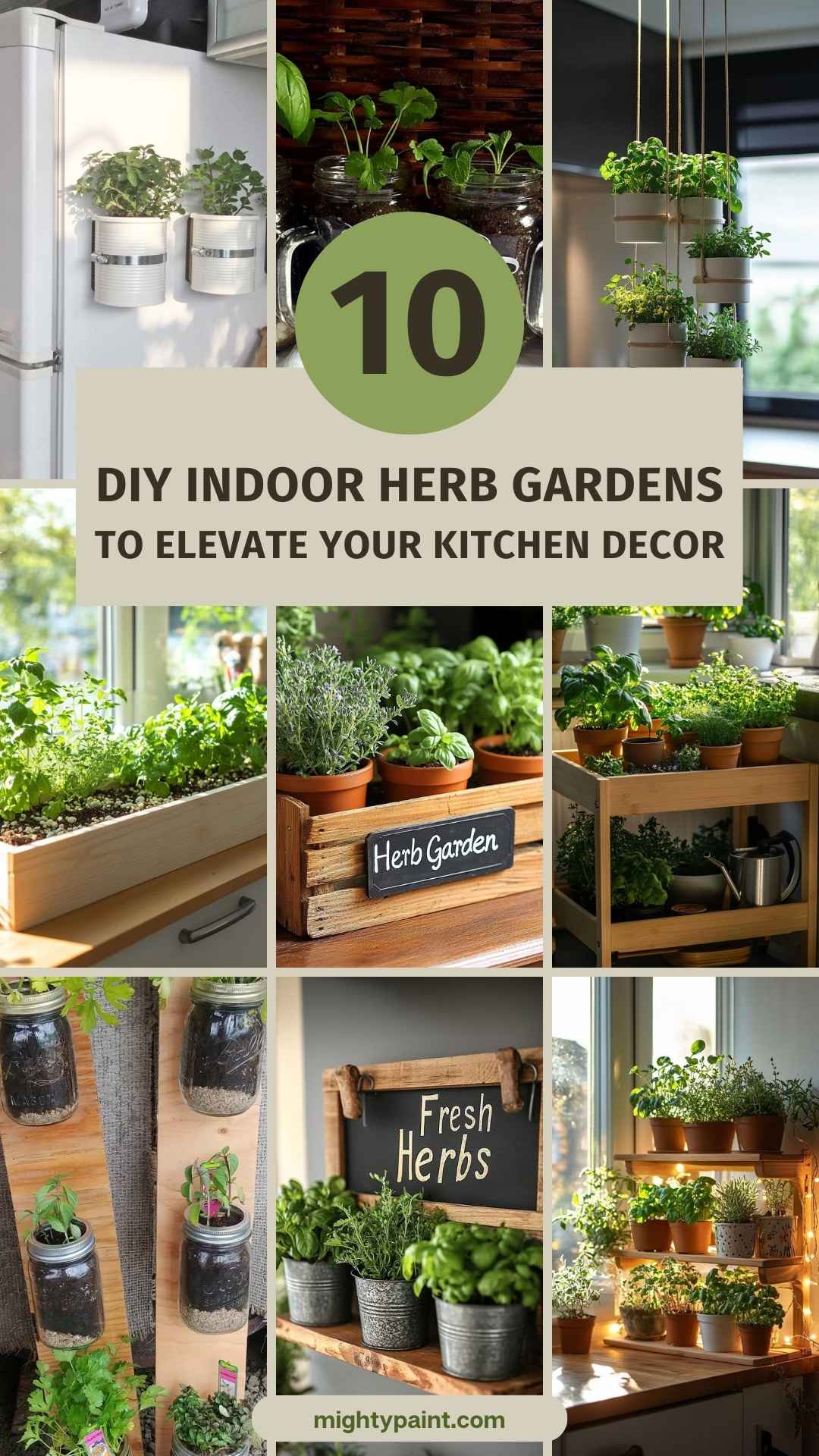
Indoor herb gardens are perfect for any home—whether you have a spacious kitchen or a small apartment. From hanging planters to countertop mason jars, there are endless ways to create a garden that fits your space and style. These DIY herb garden ideas will help you transform your kitchen into a fresh, green-filled oasis, giving you easy access to fragrant herbs that make every meal feel special.
Get the Fail-Safe Paint Color Playbook (Free PDF)
36 proven colors • 8 ready palettes • trim & sheen guide • printable testing cards.
Get ready to roll up your sleeves and bring some greenery to your kitchen with these 10 DIY indoor herb gardens that are sure to elevate your cooking and your decor.
1. Mason Jar Herb Garden
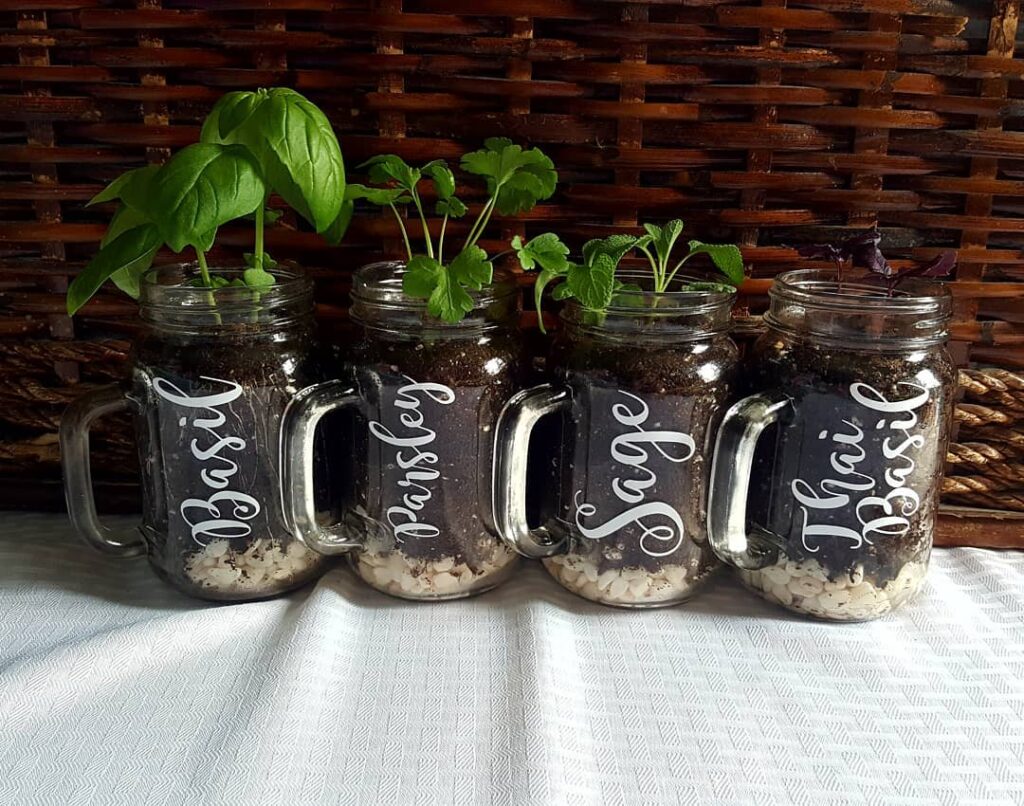
A mason jar herb garden is a simple and stylish way to grow your favorite herbs right in your kitchen. It adds a rustic, farmhouse vibe while giving you fresh herbs at your fingertips.
Materials Needed: To create this herb garden, you’ll need mason jars, potting soil, herb seeds or seedlings, and small stones for drainage. You can easily find these materials at any gardening store or even repurpose jars you already have.
How to Create: Start by adding a layer of small stones or pebbles to the bottom of each mason jar. This helps with drainage and prevents the roots from sitting in water. Next, fill the jar about three-quarters full with potting soil, and plant your herb seeds or seedlings. Gently press the soil down, and water lightly. Make sure not to overwater, as mason jars don’t have drainage holes.
Placement Tips: Place your mason jar herb garden on a windowsill or a shelf that receives plenty of sunlight—most herbs need about 6-8 hours of sunlight per day. If your kitchen lacks natural light, consider placing your jars under a small LED grow light to ensure healthy growth.
Decor Bonus: For a more organized look, label each jar using chalkboard labels or tie twine around the jar with a handwritten tag. The rustic look of mason jars fits perfectly with many kitchen styles, adding both functionality and charm to your space.
Why It Works: Mason jars are great for indoor herb gardens because they are easy to maintain and add a rustic decorative touch. They work well in both small and large kitchens and make it easy to keep herbs on hand for cooking.
2. Hanging Herb Garden

A hanging herb garden is perfect for kitchens where counter space is limited. This vertical option lets you grow herbs without sacrificing any precious kitchen real estate, while adding a decorative element to your walls or ceiling.
Materials Needed: To create this garden, you’ll need hanging planters, herb seedlings, potting soil, and sturdy hooks to secure the planters. You can use macramé plant hangers or metal hanging pots—choose a style that complements your kitchen decor.
How to Create: Start by filling your hanging planters with potting soil, then add your herb seedlings. Be sure the containers have good drainage, as hanging planters tend to collect water at the bottom. Secure the hooks to the ceiling or wall near a window that gets plenty of sunlight, and hang the planters at different heights to add visual interest.
Placement Tips: Hang the herb garden near a window with good natural light—ideally above your sink or along an empty wall. This placement keeps your herbs easily accessible while brightening up the kitchen.
Decor Bonus: Use planters in complementary colors or even metallic tones for a more modern look. If you’re using macramé hangers, choose ones with natural colors to give your kitchen a bohemian touch. Adding a few faux vines in between the hanging planters can further enhance the look.
Why It Works: The hanging herb garden saves valuable counter space while allowing you to grow multiple herbs. It’s a great option for small kitchens and also serves as a decorative piece, adding natural texture and greenery to your home.
Get the Fail-Safe Paint Color Playbook (Free PDF)
36 proven colors • 8 ready palettes • trim & sheen guide • printable testing cards.
3. Vertical Wall Garden

A vertical wall herb garden is not only practical but also serves as a living art piece in your kitchen. This DIY project makes use of vertical space, making it ideal for smaller kitchens that need a pop of greenery.
Materials Needed: You will need a wooden or metal wall rack, small pots, herb plants, and screws to secure the rack. You can also use S-hooks to attach the pots to the rack if you want flexibility in their arrangement.
How to Create: Start by mounting the wall rack to a kitchen wall that gets plenty of natural light. Then, fill your small pots with potting soil and herbs, and hang them on the rack using hooks or clips. Arrange the pots in rows or staggered for a visually interesting look.
Placement Tips: Place your vertical wall garden near a sunny wall in the kitchen. If possible, put it near your cooking area so you can easily snip off herbs while preparing meals.
Decor Bonus: Use pots in different colors or materials to add vibrancy, or stick to a neutral color scheme for a minimalist look. You could also add a small chalkboard sign on the rack, labeling your herbs and giving it a rustic, café-style feel.
Why It Works: A vertical wall herb garden is perfect for utilizing vertical space that otherwise might be unused. It brings a splash of greenery and life to your walls, adding both functionality and decor to your kitchen in one go.
4. Repurposed Tin Can Herb Garden
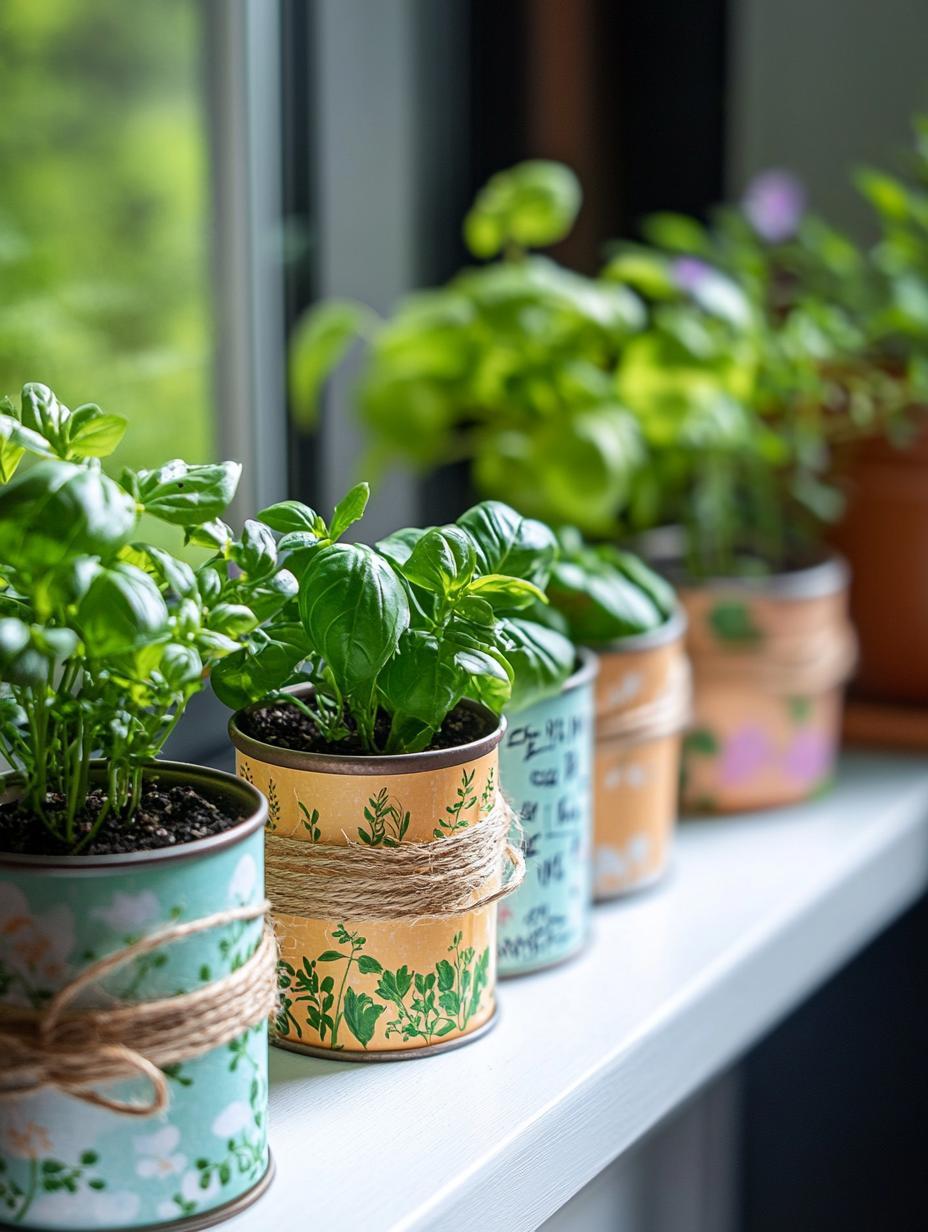
For an eco-friendly twist, why not create a herb garden out of repurposed tin cans? This DIY project is perfect for those who love upcycling and want to add a unique, rustic touch to their kitchen.
Materials Needed: Gather empty tin cans, paint (optional), labels, potting soil, and herb seeds. If you want to dress up your cans, you can use acrylic paint to match your kitchen decor.
How to Create: Start by cleaning the empty tin cans thoroughly, then paint them if desired. You can paint each can a different color, or keep them consistent for a more uniform look. Once dry, fill each can with potting soil and plant your herb seeds or seedlings. Be sure to drill a few holes in the bottom of the cans for drainage.
Placement Tips: Place your repurposed tin cans on a windowsill, a counter, or even mount them to a wooden board that can be hung on the wall. This gives your herbs the sunlight they need while adding charm to your space.
Decor Bonus: Decorate the cans with chalkboard paint and label each herb for a charming, farmhouse-style touch. You could also tie twine around the cans and add a small tag with the herb’s name to give it an extra rustic feel.
Get the Fail-Safe Paint Color Playbook (Free PDF)
36 proven colors • 8 ready palettes • trim & sheen guide • printable testing cards.
Why It Works: Repurposed tin cans add a charming, rustic vibe to your kitchen, and they are a great way to recycle items you already have at home. This herb garden idea is simple, inexpensive, and perfect for anyone who wants to bring a bit of DIY creativity into their kitchen decor.
5. Tiered Herb Garden Shelf
A tiered herb garden shelf is an attractive way to add dimension to your kitchen while keeping your herbs accessible. This setup provides plenty of room for multiple herbs, making it both decorative and highly functional.

Materials Needed: To create this garden, you’ll need a tiered shelf (either wood or metal), herb pots, and potting soil. You can buy a tiered plant stand or repurpose a small bookshelf.
How to Create: Arrange your herb pots on each level of the tiered shelf, filling each pot with soil and herbs of your choice. Make sure that the pots on the lower tier still get enough light by positioning the shelf near a window or under a grow light.
Placement Tips: Position your tiered shelf in a corner of your kitchen or next to a window where the herbs can get sufficient sunlight. This makes it easy to grab fresh herbs while cooking without taking up precious countertop space.
Decor Bonus: Use herb pots in different colors and sizes to add visual interest and a dynamic look to the shelf. Adding small decorative items, like miniature garden gnomes or fairy lights, can make the herb garden even more charming.
Why It Works: The tiered herb garden shelf is ideal for those who want to grow a variety of herbs without using a lot of counter space. It’s also a beautiful way to display herbs and adds depth to your kitchen decor.
6. Magnetic Herb Garden on the Fridge
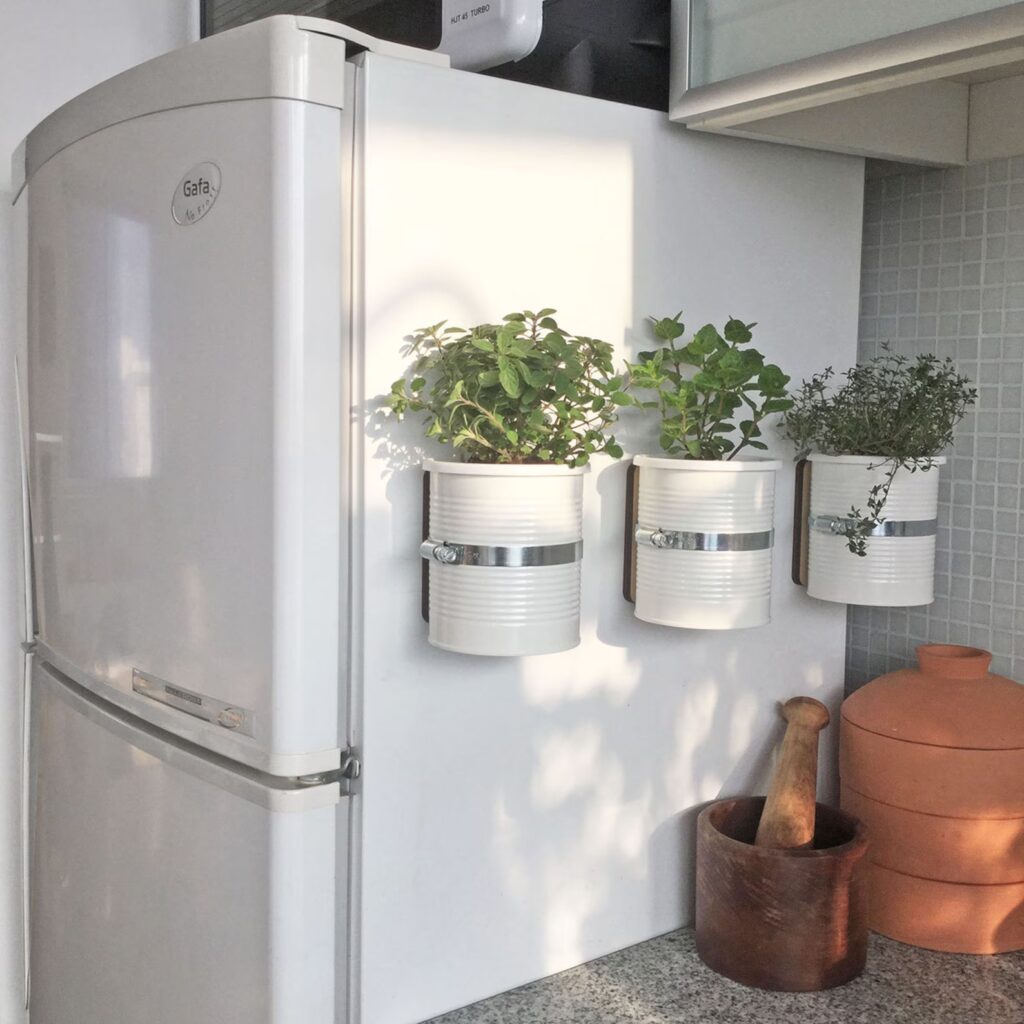
For a fun and space-saving herb garden idea, try a magnetic herb garden on your fridge. This clever solution not only utilizes unused space but also keeps your herbs conveniently close while cooking.
Materials Needed: To create this garden, you’ll need magnetic containers, potting soil, herb seeds or seedlings, and strong magnets. You can either buy magnetic pots or DIY your own by attaching strong magnets to small metal containers.
Get the Fail-Safe Paint Color Playbook (Free PDF)
36 proven colors • 8 ready palettes • trim & sheen guide • printable testing cards.
How to Create: Fill each magnetic container with potting soil, and plant your herb seeds or seedlings. Attach strong magnets to the back of each container if you’re making them yourself, and ensure they are secure. Stick the containers to your refrigerator, and watch your herb garden grow!
Placement Tips: Place the containers in a spot on the fridge that gets indirect light—preferably near a window. Herbs like basil, thyme, and oregano work well in this setup because they’re relatively low maintenance.
Decor Bonus: Use matching containers for a clean, cohesive look, or go for an eclectic vibe with a mix of bright colors. You could also use small chalkboard labels to identify each herb, making your magnetic herb garden both functional and decorative.
Why It Works: This herb garden idea is perfect for small kitchens with limited space. It keeps your herbs in plain sight and easily accessible without using up valuable countertop or shelf space. Plus, it adds an unexpected touch of greenery to your kitchen decor.
7. Herb Garden Windowsill Box
A windowsill herb garden box is a classic choice for those who love simplicity and convenience. It allows you to grow multiple herbs in one long container, making the most of your sunny kitchen window.

Materials Needed: You’ll need a long rectangular planter box, herb seedlings, potting soil, and optionally some paint if you’d like to personalize the planter.
How to Create: Fill the windowsill box with potting soil, and plant your herb seedlings. Make sure to space the herbs evenly, allowing enough room for each plant to grow. Water gently after planting, and ensure the box has drainage holes to prevent water from accumulating.
Placement Tips: Place the herb garden box directly on your windowsill—ideally one that gets plenty of sunlight. It’s the perfect location for easy access while cooking, and it also serves as a beautiful decor element.
Decor Bonus: Paint the planter box to match your kitchen’s color scheme, or add decorative labels to identify each herb. Adding a few decorative stones on top of the soil can also enhance the look, giving it a neat, polished appearance.
Why It Works: A windowsill herb garden box is easy to manage and allows you to grow multiple herbs in one place. It makes use of natural light and is ideal for anyone who loves the convenience of having fresh herbs just an arm’s length away.
8. Upcycled Wooden Crate Herb Garden
If you love rustic decor, an upcycled wooden crate herb garden is an excellent option for adding farmhouse charm to your kitchen. This idea is perfect for those who enjoy repurposing and want something unique.

Materials Needed: You’ll need a small wooden crate, herb pots, potting soil, and chalkboard labels or tags. You can often find crates at craft stores or repurpose one you already have.
How to Create: Fill the wooden crate with herb pots that are filled with soil and herb seedlings. You can arrange the pots in the crate so that they are close together, making a compact and decorative garden. Make sure the pots have drainage holes to prevent overwatering.
Placement Tips: Place the crate on your countertop or mount it to the wall if you have enough space. The rustic look of the crate adds character to your kitchen while keeping your herbs easily accessible.
Decor Bonus: Use chalkboard labels or small tags to identify each herb, adding a farmhouse touch to the garden. You could also tie a burlap ribbon around the crate or add some decorative accents like dried flowers to enhance the rustic look.
Why It Works: This herb garden idea not only gives you fresh herbs but also adds rustic decor to your kitchen. It’s easy to move around and provides a lot of visual interest, making it a great choice for those who love farmhouse-style design.
9. Hanging Glass Bottle Herb Garden
A hanging glass bottle herb garden is an eye-catching way to add a unique and sustainable element to your kitchen. This project uses recycled glass bottles to create a beautiful, functional piece of kitchen decor.
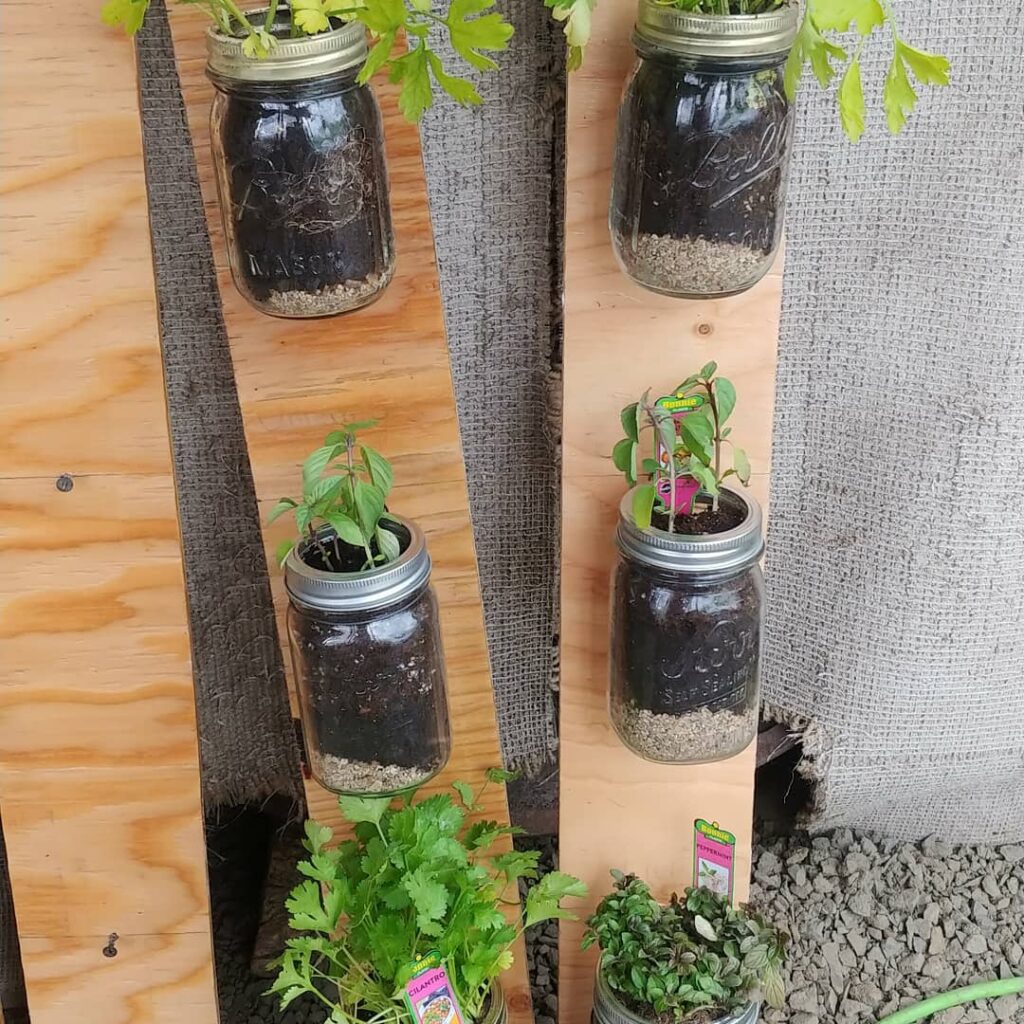
Materials Needed: You’ll need recycled glass bottles, rope or wire, potting soil, herb seedlings, and a sturdy rod or hooks for hanging. The bottles can be any shape or size, as long as they can hold enough soil for your herbs.
Get the Fail-Safe Paint Color Playbook (Free PDF)
36 proven colors • 8 ready palettes • trim & sheen guide • printable testing cards.
How to Create: Cut the bottles in half or use them as-is if they are open at the top. Secure the bottles with wire or rope, and fill them with potting soil. Plant the herb seedlings, then hang the bottles from a sturdy rod or hooks mounted to your kitchen wall or ceiling.
Placement Tips: Hang the bottles in a spot that gets adequate light—ideally near a window. You can hang them at varying heights for added visual interest. Be sure to check that they are secure, as glass bottles can be heavy when filled with soil and water.
Decor Bonus: Let the sunlight pass through the glass bottles to create beautiful reflections in your kitchen. Choose bottles of different colors for a more vibrant look, or stick with clear glass for a classic, simple appearance.
Why It Works: This herb garden not only provides fresh herbs but also serves as a beautiful art installation in your kitchen. The recycled glass bottles add an eco-friendly touch, and the hanging design saves counter space while making a bold statement.
10. Herb Garden on a Rolling Cart
A rolling herb garden cart is a fantastic option for those who want flexibility and convenience. This mobile garden can be moved around to capture the best light or brought close to the cooking area for easy access.

Materials Needed: You’ll need a small rolling cart, herb pots, potting soil, and herb seedlings. You can use a kitchen cart or even repurpose an old bar cart for this DIY herb garden.
How to Create: Fill the pots with potting soil and plant the herbs of your choice. Place the pots on the different levels of the rolling cart, with the smaller plants on top and larger ones on the bottom for better light distribution.
Placement Tips: Position the cart near a window during the day to give your herbs optimal light. When cooking, you can easily roll the cart to your prep area, making it super convenient to snip off fresh herbs as needed.
Decor Bonus: Decorate the cart with small gardening tools, such as a mini watering can, or add fairy lights around the frame for a whimsical touch. A few small decorative items like a framed kitchen quote can also make the cart more visually appealing.
Why It Works: The rolling herb garden cart is practical, flexible, and perfect for any kitchen setup. It allows you to move your herbs to where they can get the best light, and it’s easy to bring them closer when you need them. Plus, it adds a charming, cottage-like vibe to your kitchen.
How to Care for Your Indoor Herb Garden
Successfully growing herbs indoors requires a little care and attention. Here are some essential tips to keep your herb garden thriving:
Watering Tips
- Herbs prefer well-drained soil, so water them regularly but sparingly to prevent root rot. Make sure to check the moisture level of the soil before watering.
Sunlight Requirements
- Most herbs need at least 6-8 hours of sunlight per day. Place them near a sunny window or supplement with LED grow lights if needed.
Pruning and Harvesting
- Regular pruning encourages healthy growth and keeps herbs from becoming too leggy. Don’t be afraid to harvest often—herbs grow best when regularly snipped.
Choosing the Right Herbs for Your Kitchen
When creating an indoor herb garden, choosing the right herbs is key to ensuring your success. Here are some tips on selecting herbs that suit both your culinary needs and the conditions of your kitchen:
Easy-to-Grow Herbs
If you’re just starting out, choose herbs that are easy to care for and grow well indoors. Here are some great options:
- Basil: Ideal for beginners; it thrives with plenty of sunlight and adds wonderful flavor to dishes.
- Mint: Grows quickly and can be used for teas, desserts, and garnishes.
- Rosemary: Hardy and aromatic, it adds depth to many savory recipes.
- Thyme: Perfect for seasoning roasted vegetables, meats, and stews.
- Parsley: A versatile herb used in many dishes, from soups to salads.
Herbs for Specific Uses
Think about the types of meals you love to cook and choose herbs that suit your style:
- For Italian Cuisine: Grow basil, oregano, and thyme to add authentic flavor to pasta, sauces, and pizzas.
- For Mexican Dishes: Cilantro is essential for salsas, tacos, and guacamole.
- For Teas and Desserts: Mint and lemon balm are great for fresh teas, desserts, and cocktails.
Container Selection
When choosing containers, make sure they have good drainage holes to prevent water from building up in the soil. Herbs love well-drained soil, and proper containers are essential for maintaining healthy roots.
Adding Style to Your Herb Garden Setup
In addition to being practical, an herb garden can also serve as a stylish addition to your kitchen. Here are some ways to make your indoor herb garden not only functional but also visually appealing:
Personalize with Labels
Labeling your herbs can make your garden look organized and charming. You can use:
- Chalkboard Labels: Stick these on the pots for a rustic touch. You can easily erase and rewrite names when you change herbs.
- Wooden Tags: Create small wooden tags with each herb’s name and stick them in the soil.
- Printed Labels: Design and print stylish labels that match your kitchen decor.
Decorate the Planters
Make your herb garden stand out by decorating the planters:
- Paint the Pots: Choose colors that match or contrast with your kitchen’s color scheme. Patterns like stripes, florals, or polka dots can add personality to the garden.
- Wrap with Jute Twine: Wrap the planters with jute twine for a rustic or farmhouse look, adding texture and warmth to your kitchen.
Incorporate Lighting
If your kitchen lacks natural light, consider adding small LED grow lights to help your herbs thrive. These can also serve as decorative elements:
Get the Fail-Safe Paint Color Playbook (Free PDF)
36 proven colors • 8 ready palettes • trim & sheen guide • printable testing cards.
- Under-Cabinet Grow Lights: These lights can be installed under kitchen cabinets to give your herbs the light they need without taking up counter space.
- Clip-On LED Lights: Clip-on grow lights can be attached to shelves, providing focused light for individual herbs.
How to Care for Your Indoor Herb Garden
An indoor herb garden requires ongoing care to thrive, and here are some essential care tips to keep your herbs healthy and lush:
Watering Tips
- Herbs need well-drained soil to avoid root rot. Water them regularly, but ensure the soil isn’t soggy. The best practice is to water when the top inch of soil feels dry.
- Use containers with drainage holes to prevent excess water from accumulating, as herbs don’t like sitting in water.
Sunlight Requirements
- Most herbs need at least 6-8 hours of sunlight daily. Place your garden near a south- or west-facing window to get the best light.
- If natural sunlight is limited, supplement with LED grow lights to keep your herbs healthy and growing throughout the year.
Pruning and Harvesting
- Regular pruning keeps herbs healthy and promotes new growth. Snip off the top leaves frequently, even if you’re not using them, to prevent the plant from becoming leggy.
- Harvest often but avoid cutting more than one-third of the plant at a time to ensure continued growth.
Enhancing Your Kitchen Decor with an Herb Garden
An indoor herb garden not only provides fresh ingredients but also enhances your kitchen decor. Here are some ways to make your herb garden a standout part of your kitchen:
Create a Cohesive Look
- Coordinate your herb garden with the rest of your kitchen decor. If your kitchen has a rustic theme, opt for wooden or terracotta planters. For a modern kitchen, use sleek ceramic pots in neutral tones.
- Arrange your herb garden in a way that complements your kitchen layout. A windowsill garden looks beautiful in a classic kitchen, while a vertical wall garden can add a contemporary touch.
Use Greenery to Brighten the Space
- Greenery adds vibrancy to any room, and an herb garden can help liven up your kitchen. Place herbs in areas that could use a pop of color, such as a bare windowsill or an empty corner.
- Use trailing herbs like oregano or thyme in hanging planters to add a lush, cascading effect that softens the edges of your kitchen.
Decorative Accents for the Herb Garden
- Incorporate decorative accents like small figurines, miniature garden signs, or fairy lights to make your herb garden visually interesting and inviting.
- Consider adding decorative shelves for tiered herb gardens, which can turn your herbs into a display piece and draw the eye upward, making your kitchen feel larger.
Conclusion
Indoor herb gardens are the perfect combination of form and function—bringing nature indoors while offering the convenience of having fresh herbs at your fingertips. Whether you choose mason jars, hanging planters, or a rolling cart, these DIY ideas can transform your kitchen into a vibrant, green-filled oasis that will elevate your cooking and decor.
Growing your own herbs isn’t just about flavoring your dishes; it’s about creating a cozy and inspiring space that adds warmth and character to your kitchen. With these 10 indoor herb garden ideas, you can bring nature inside, enhance your decor, and enjoy the satisfaction of growing something yourself.
So, which herb garden idea are you going to try? Pick a project that suits your space, get creative, and start growing a beautiful indoor garden today!
